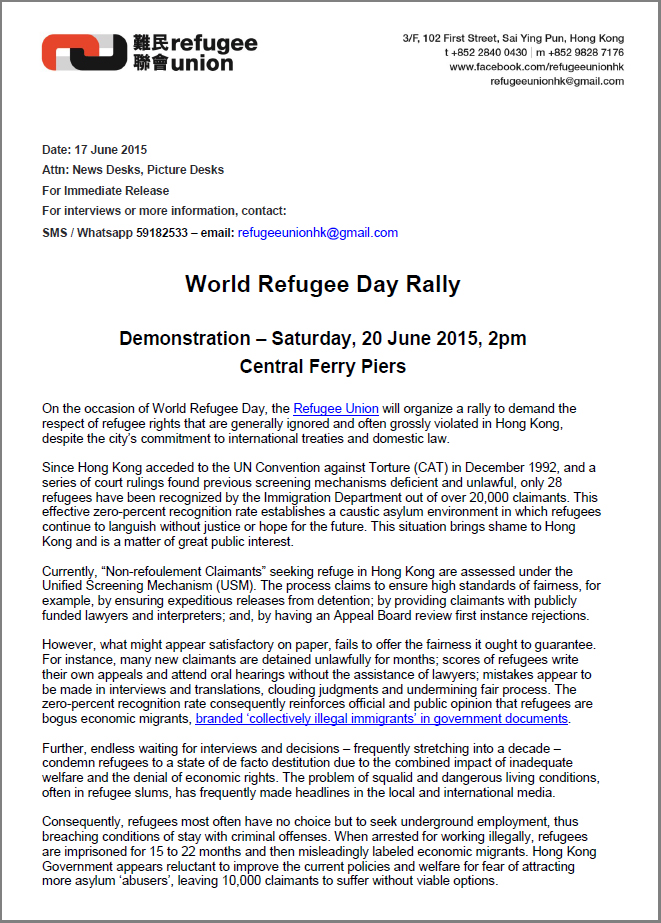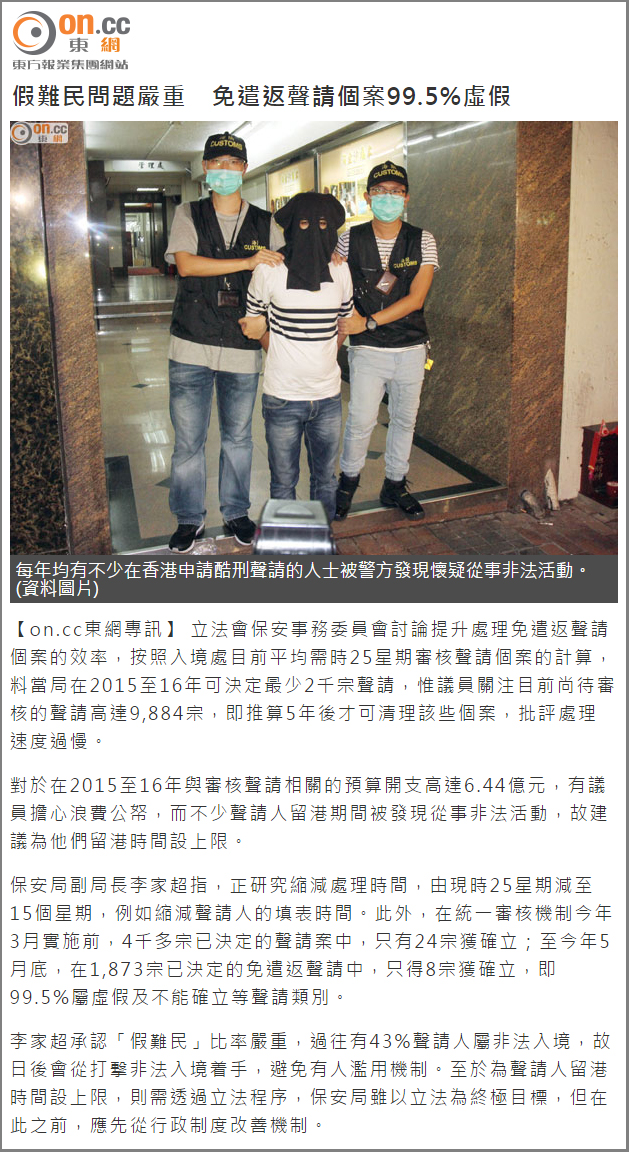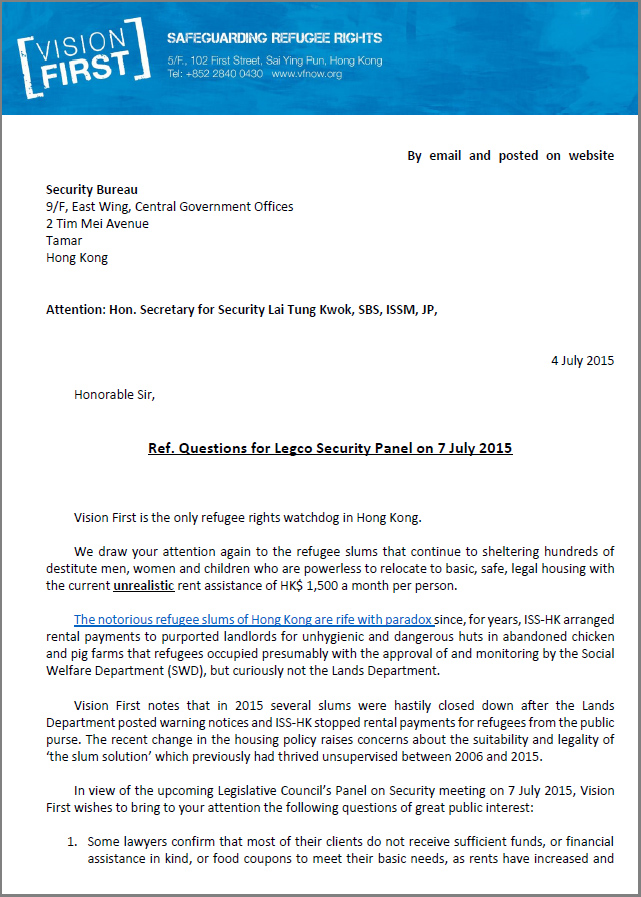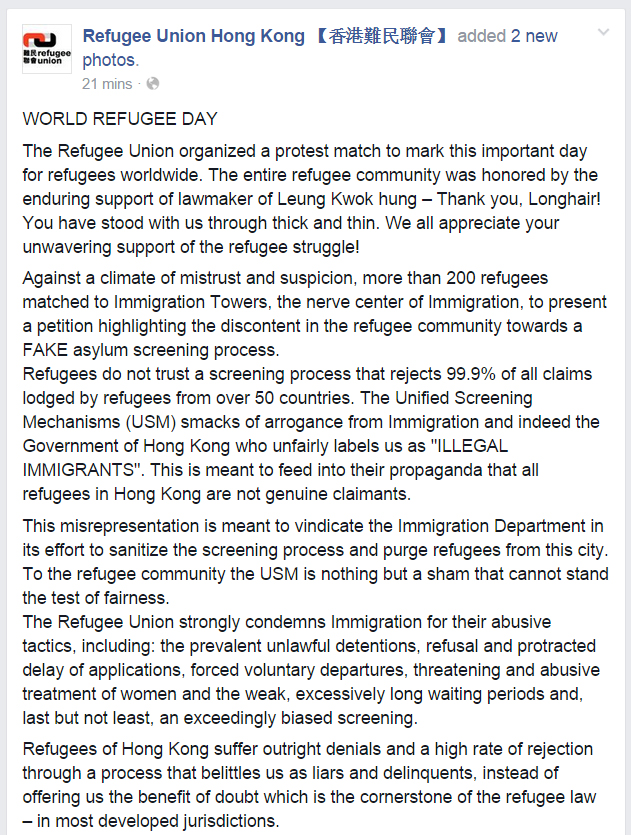Misinformation raises hysteria around refugee abuse
Jul 8th, 2015 | Immigration, Rejection, VF Opinion | Comment
The Legislative Council Security Panel meeting of 7 July 2015 failed to shed light on the structural problems that have drawn criticism to the Unified Screening Mechanism (USM) and its questionable 0.5% acceptance rate. The Security Bureau report that “amongst the 1873 non-refoulement claims determined by Immigration, 8 are substantiated”, figures that were sensationally echoed in the Chinese press as “99.5% of non-refoulement claimants are false”. Is that really the truth?
Vision First introduced the discussion on acceptance rates in 2012, when we first questioned the credibility of the Immigration Department’s effective Zero Percent Acceptance Rate that not only fails to protect persecuted foreigners, but is manipulated to brand refugees as abusers who should be expeditiously deported. Statistics however are only useful if provided with context and analysis.
A case in point is the period refugees wait for decisions – namely rejection. The Security Bureau reported that “since the commencement of USM, it takes Immigration about 25 weeks on average to decide on a claim”. However such an average is limited to the 1873 cases already determined. It does not include hundreds of refugees who arrived many years ago and, either have not been screened, or still await first-tier or second-tier determinations.
Vision First is aware of numerous refugees whose Torture Claims, in some cases filed years before the USM was launched, were not decided. The authorities have suggested that they may request prioritized screening, but what incentive do they have with a 99.5% certainty of being refused and then facing removal into harm’s way? Is it possible that Immigration avoids determining cases that are hard to refuse and might then cause embarrassment through judicial reviews? Some of these refugees have waited more than a decade.
It is certainly staggering that since the USM was launched in March 2014, a record 6461 new claims were lodged, a 250% increase on the previous year. The figure is greater than the entire refugee population was in early 2014 and might be indicative of Hong Kong’s growing status as a global city that attracts persecution, labour and poverty-induced migration. Hong Kong is apparently unable to categorize and manage them all effectively.
An analysis of the recent surge is beyond our scope. One might however consider the fact that Hong Kong has no temporary migration scheme for troubled foreigners, who don’t fit the definition of refugees, but are nonetheless fearfully reluctant to return home for a combination of reasons that may include debt, harassment, destitution and persecution. The predictable fallout from the city’s exploitation of 350,000 domestic workers should also draw attentive scrutiny.
Other issues are raised by the 43% of claimants (4250) who entered Hong Kong illegally. While the way of entry has no bearing on asylum grounds, the figure underscores border porosity and the resourcefulness of agents in eluding both Hong Kong and Chinese border controls. The problem should be raised as an indictment of immigration capacity, not as evidence of refugee deviance, because the persecuted are entitled to seek asylum through any channels – legal or clandestine.
Finally, the 0.5% acceptance rate may be challenged in relation to Pakistan that represents the top country of origin for refugees seeking sanctuary in Hong Kong (20%). Any cursory internet search reveals that Pakistan suffers appalling human rights violations, as well as violence against religious minorities, women, journalist, activists and underclass ethnic/tribal minorities. The government’s inability to guarantee security and eradicate corruption are further concerns.
Vision First puts forward two sets of data for further consideration and analysis.
Australia acceptance rate of Pakistani refugees:
- in 2012-13 — 80%
- in 2011-12 — 75%
- in 2010-11 — 80%
- in 2009-10 — 84%
- in 2008-09 — 76%
Hong Kong acceptance of Pakistani refugees, since the ratification of the UN Convention against Torture:
- from 1992 till July 2015 — ZERO
QUESTION: Do fake Pakistani refugees avoid Australia to come here, or is the USM fake?
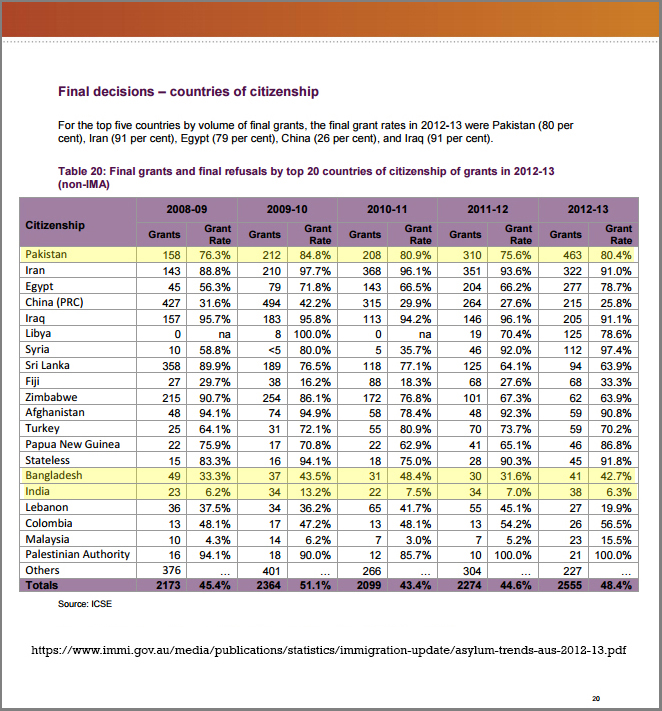
Webcast of Legislative Council Security Panel on 7 July 2015
Jul 8th, 2015 | Government, Immigration, Rejection | Comment
Agenda item no. 4: Unified screening mechanism for non-refoulement claims
LC Paper No. CB(2)1832/14-15(03) – Paper provided by the Administration
LC Paper No. CB(2)1832/14-15(04) – Background brief prepared by the Legislative Council Secretariat
Discussion starts at the 15:39 time marker
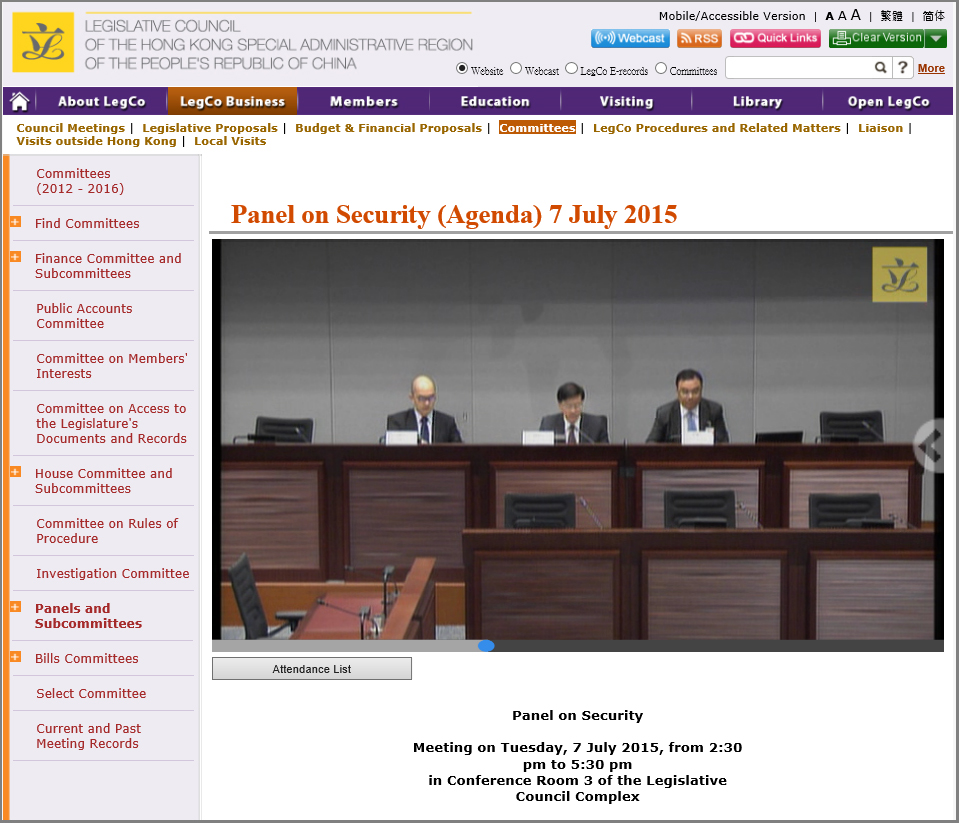
Open letter to the Security Bureau for the Legco Security Panel on 7 July 2015
Jul 4th, 2015 | Advocacy, Government, Housing, Immigration, Rejection, VF Opinion | Comment
Security Bureau update for Legco’s Security Panel on 7 July 2015
Jul 3rd, 2015 | Government, Immigration, Rejection | Comment
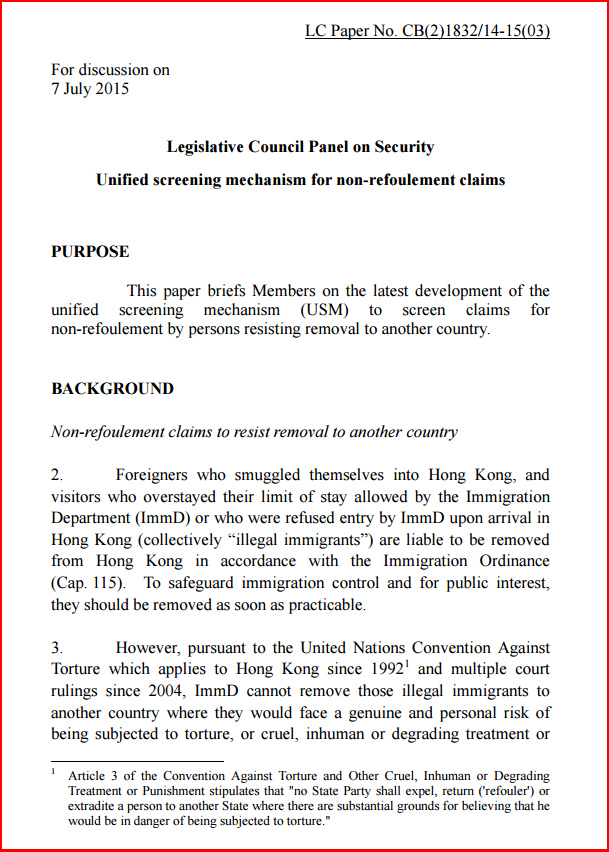
USM is a mechanism of border control not refugee protection
Jul 2nd, 2015 | Advocacy, Immigration, Rejection, VF Opinion | Comment
In view of the very low acceptance rate of the Unified Screening Mechanism (USM), perhaps it is necessary to rethink the purpose of this mechanism. Vision First suggests that at the Legislative Council’s Panel on Security on 7 July 2015, lawmakers re-examine the implementation of the USM and its usefulness to taxpayer who this year will foot a 644 million dollar bill to operate what refugees dubbed a ‘fake’ scheme.
Given that the Government bluntly refuses to grant asylum and brands refugees as illegal immigrants, what rational and objectives have supported Hong Kong’s asylum process since 1992? The city’s masterminds are too savvy to operate exclusively on the premise of moral obligations towards the international refugee problem, as states are rarely motivated by moral responsibility alone.
The USM seems to be characterized by its migration control function, rather than the Government’s international duty to safeguard persecuted foreigners. Like its predecessors, the USM does not offer sanctuary. Rather it exerts state power to confine, control and ultimately expel an unwanted migrant population.
Government propaganda successfully homogenized refugees with economic migrants, illegal immigrants and travelling outcasts stigmatized as a risk to Hong Kong’s security and affluence. Within this self-serving masterplan, the USM is deployed as a MECHANISM OF BORDER CONTROL to relentlessly banish asylum seekers, stateless persons, failed (often pregnant) domestic workers, economic migrants and other misfits perceived as a nuisance after a few years of exploitation.
The Government is less than sincere about even granting non-refoulement protection, or else considerably more than 28 refugees would have been identified and assisted since 1992. Such negligible results indicate that the asylum process has routinely performed the function of rejecting undesirable border-crossers, rather than protecting vulnerable refugees.
Although it is unlikely that pro-establishment lawmakers will question the status quo, and it is improbable that challenges from the opposition will be anything more than noted, Vision First presents a set of questions of public interest for the upcoming Legislative Council’s Panel on Security meeting:
- How many claims were substantiated since the launch of USM? And how many claimants currently enjoy non-refoulement in Hong Kong (including CAT)? Please specify the ratio between substantiated claims and outstanding claims and whether successful cases were Torture, CIDTP or Persecution? (VF bets they were all Persecution to expel them from Hong Kong via the UNHCR)
- When will the USM be amended to include assessment of Bill of Right Art. 2 “Right to Life” claims?
- Why are USM claimants not allowed to work in Hong Kong despite living in destitution?
- What evidence can the Security Bureau provide that allowing asylum seekers to work would lead to a massive influx of new arrivals into Hong Kong?
- Why are USM claimants arrested for working illegally and given longer jail sentences compared with visitors and/or overstayers?
- Some local NGOs claim that the level of welfare assistance given to USM claimants is too low for individuals to subsist, making it necessary for them to work illegally in the city. What’s the Bureau’s response to this claim?
- Some lawyers confirm that most of their clients do not receive sufficient funds, or financial assistance in kind, or food to meet their basic needs as rents have increased and inflation has outstripped what amounts the SWD provides. This leaves them with no choice but to beg and frequently resort to working illegally. Is it not a fact that the increase in rents has outstripped the rental assistance provided to claimants?
- Do you agree that thousands of asylum seekers lived for years, and hundreds continue to live, in abandoned chicken and pig farms sanctioned by the government as these were/are the only locations affordable based on government rent assistance?
- Do you agree that such pig and chicken farms are not zoned for residential living? Is the government investigating why this happened and who is responsible for distributing public money to pay for illegal structures?
- Will anyone be prosecuted for allowing dozens of refugee slums to develop and operate on funds paid from the public purse between 2006 and 2015?
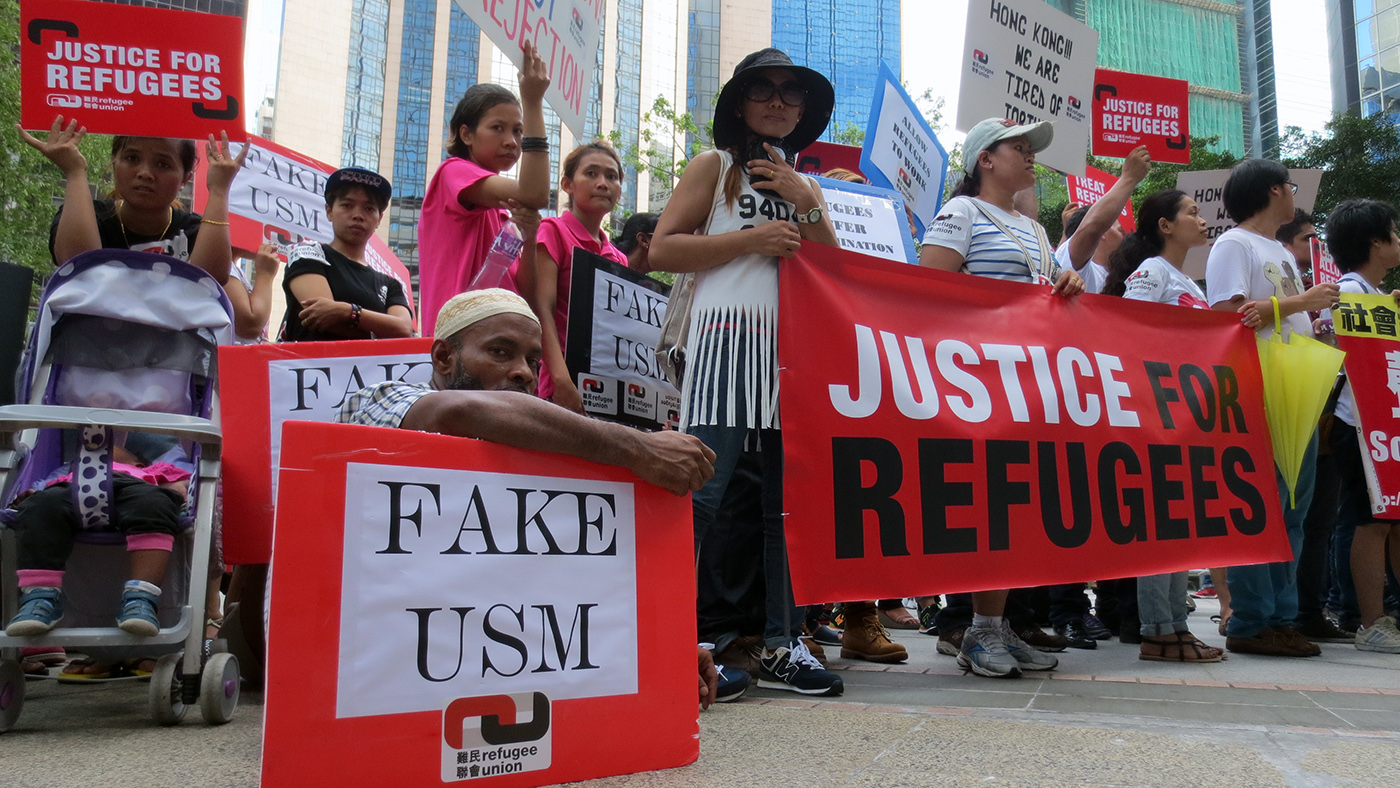
Is Hong Kong intentionally an asylum black hole?
Jun 29th, 2015 | Immigration, Rejection | Comment
The Unified Screening Mechanism (USM) was introduced on 3 March 2014 “to determine claims for non-refoulement protection against expulsion, return or extradition from Hong Kong to another country on applicable grounds including risks of torture … cruel, inhuman or degrading treatment or punishment … and persecution”. It replaced a much maligned two-track system that combined Immigration and UNHCR, which was found wanting by the courts.
Although the development might appear as an improvement to most observers, refugees’ dissatisfaction with USM is growing. An effective zero percent acceptance rate persists; one which saw just 28 successful cases out of 20,000 application since the UN Convention against Torture was extended to Hong Kong in 1992 – or exactly 0.14%. Refugees know that statistics do matter.
As Hong Kong did not accede to the UN Refugee Convention, direct comparisons with country states are unsatisfactory. Nevertheless, success rates in developed countries average 20 to 40% yearly, with Australia at 48% and Canada at 50% despite stricter policies “discouraging bogus asylum seekers and sending them home more quickly”. Is Hong Kong intentionally an asylum black hole?
Refugees seeking sanctuary in Asia’s World City struggle to reconcile the offer of protection with the effective rejection of 99.86% of claims. As a refugee stranded here for 10 years put it, “What’s the point of USM? It’s like torture screening before: nobody wins their case. My torture claim was rejected but I cannot go to another place because my passport expired. Hong Kong does not accept me so I am stateless. Refugees are refused and left to rot in poverty.”
The thin hope sustaining refugees in limbo sadly borders on delusion. On the one hand, they know their asylum bid will fail, but on the other, they cannot give up, because “hope is all that is left.” In the face of overwhelming odds, refugees keep waiting for a positive outcome supported more by faith, than a critical understanding of a system ostensibly intended to guarantee rejection.
In the words of a refugee mother, “It’s a fake system! It looks prim and proper with thick documents and reams of files, with duty lawyers and fancy titles, but the result is always the same. ‘Your case is not substantiated’, says Immigration. You are refused. They tell you to bring your suitcase to CIC (detention) for removal. They want to send everyone back. Perhaps my case was not strong, but how about the other 2000 they will close this year?”
The Government is blunt and makes no secret of an overt policy, “Non-refoulement claims lodged under the USM are not asylum claims … The Government maintains a firm policy of not granting asylum to or determining the refugee status of anyone … Our policy objective is to screen non-refoulement claims effectively and … to remove rejected claimants from Hong Kong as soon as possible.”
The message is clear – Hong Kong does not grant asylum. USM could be viewed as an arrangement to suspend the repatriation of claimants until refused or, if substantiated, until “the risk giving rise to the claim has ceased to exist (and …) ImmD will consider revoking his non-refoulement protection and removing him from Hong Kong.” According to such a policy, successful USM claimants are tolerated until conditions in the risk state become safe to repatriate. The circle is then closed by an agreement with UNHCR to resettle successful persecution claimants.
While refugees lament that the USM is fake, there is however consistency between the words spoken and the actions taken by the authorities. Branded collectively as illegal immigrants, refugees are treated as delinquents at worst, or a nuisance at best, to be removed as expeditiously as possible by the Immigration Department that “handles every step of the screening procedures in accordance with the high standards of fairness required by law”.
Perhaps the USM is not fake. Perhaps it achieves the results envisioned by its architects, whose irritation might be reflected by an appeal magistrate who reportedly castigated a refugee stranded since 2004: “Why you come to Hong Kong? You asylum seekers are a problem for us … We are giving you everything … Do you want a 5 star hotel?” The judge then abruptly rose and adjourned the case. Will this refugee have to wait another decade before receiving protection?
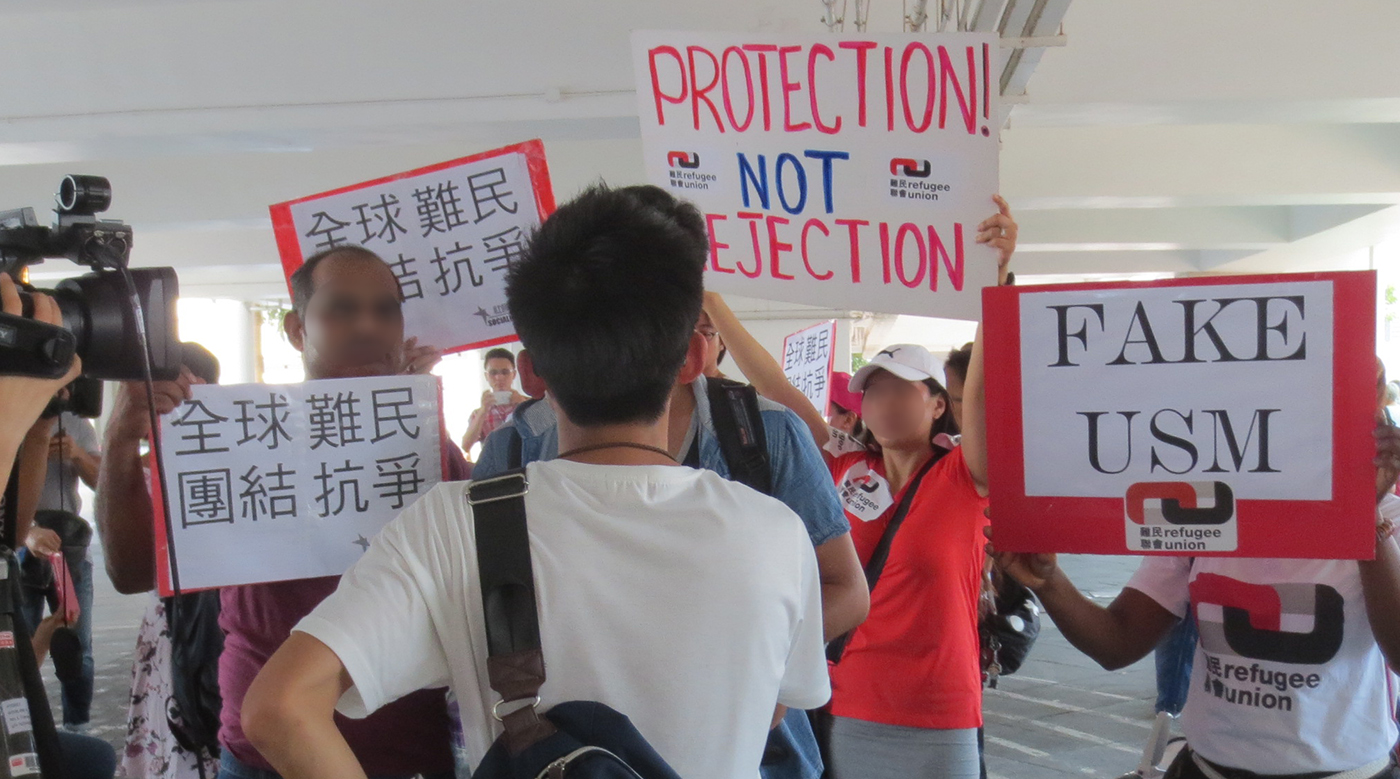
Refugee Union reports on World Refugee Day rally
Jun 23rd, 2015 | Advocacy, Immigration, Refugee Community, Rejection | Comment
Does Hong Kong favour fake systems?
Jun 19th, 2015 | Immigration, Rejection, VF Opinion | Comment
Abraham Lincoln is attributed the saying, “You can fool all the people some of the time and some of the people all the time, but you cannot fool all the people all the time.”
According to many refugees who watched a live news-feed at Vision First office, this maxim might apply to the Hong Kong’s 2017 electoral reform. Few are in any doubt about the government’s flagging popularity and the escalating challenges it is likely to face after a pro-establishment walk-out bungled the historical vote: 28 No – 8 Yes.
On offer was pseudo universal suffrage for the 2017 Chief Executive election, when eligible voters were expected to cast ballots for pre-approved candidates.
An African refugee observed, “It’s like in my country. Without rigging the election, the president would never win. It is fake universal suffrage! It is meaningless because voters cannot vote for their own choice, but only vote for whoever the Government will select. Hong Kong people are not stupid! They know it is a fake system promoted to legitimize whoever is put in power.”
A Pakistani refugee exclaimed, “Before, people accepted the governor sent from London, and now, they accept the Chief Executive approved by Beijing. But don’t tell them to vote for him, or to love him. The Government offered fake elections and the people said, ‘No thank you! You choose the leader, not us. So what is the meaning of everyone going out to vote for him?’”
As he assembled a sign for the World Refugee Day demonstration, another refugee remarked, “Hong Kong likes to have fake systems. Like the asylum screening (USM). There are lawyers, officers and appeal judges doing their important work, but the process is fake. Refugees know they cannot win their claims. Just like HK voters know they cannot win the election. You cannot fool all the people all the time!”
Rooted in painfully lived experience, these observation strike a chord. On paper, the Unified Screening Mechanism appears to offer protection, but how often does it grant it? Refugees complete forms, submit documents and attend interviews hoping for positive results. And then they wait, and wait and wait. The government arm is extended, but unreachable. The invisible hand holds back the promises made.
The refugee recognition rate speaks for itself. Since the UN Convention Against Torture (CAT) was extended to Hong Kong in 1992, more than 20,000 asylum seekers lodged claims with the Immigration Department, but only 28 were ever accepted, including several children born in Hong Kong.
That’s a 0.14% acceptance rate, a far cry from the 20-50% in develop countries, see Australia for example.
Can refugees be blamed for lamenting that the screening process lacks credibility? Claimants give less weight to the Immigration Ordinance, 480 duty lawyers and appeal judges, than to protection results, known as ‘substantiated claims’.
For the men and women who fear being repatriated into harm’s way, the complex and sophisticated screening mechanism is judged by its outcome – does it protect? Until results prove otherwise, it is hard to disagree that the Unified Screening Mechanism appears to be less than genuine.

Refugee Union press release for World Refugee Day 2015
Jun 18th, 2015 | Immigration, Media, Refugee Community, Rejection | Comment
Original post on Refugee Union Facebook
